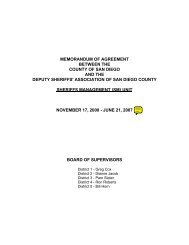MLK PARADE - Deputy Sheriffs' Association of San Diego County
MLK PARADE - Deputy Sheriffs' Association of San Diego County
MLK PARADE - Deputy Sheriffs' Association of San Diego County
Create successful ePaper yourself
Turn your PDF publications into a flip-book with our unique Google optimized e-Paper software.
How the Proposed State Budget will affect us<br />
Message from Sheriff Bill Gore<br />
When newly elected Governor Brown<br />
announced his state budget the second week <strong>of</strong><br />
January, there was a collective intake <strong>of</strong> breath<br />
statewide. With a $12.5 billion reduction in<br />
expenditures and a plan to increase revenues<br />
by $12 billion, the proposal looks squarely at<br />
California’s finances and does not shrink from<br />
the hard, ugly realities.<br />
His budget plan touches on every aspect<br />
<strong>of</strong> government—the education <strong>of</strong> children<br />
and the care <strong>of</strong> the elderly, highways and<br />
transportation, welfare and jobs, and <strong>of</strong> course<br />
law enforcement and crime. In making his<br />
public announcement, he also provided private<br />
briefings to law enforcement—and for good<br />
reason. The budget proposal contains a plan<br />
that, if implemented, will result in historic<br />
changes in criminal justice in California.<br />
In a conference call, Secretary <strong>of</strong> CDCR Matt<br />
Cate outlined key changes contained in the<br />
governor’s plan:<br />
Realignment. Under the plan, low-level felons,<br />
currently sent to State Prison, would serve<br />
their time in county jails. These criminal<br />
defendants—convicted <strong>of</strong> non-serious, nonviolent,<br />
non-sexual crimes—serve (with good<br />
time credits) an average <strong>of</strong> 11 to 12 months in<br />
State Prison. I asked Secretary Cate how many<br />
<strong>of</strong> those <strong>of</strong>fenders there were, and he estimated<br />
that there are on any given day roughly<br />
30,000 such inmates in prison. Generally,<br />
<strong>San</strong> <strong>Diego</strong> <strong>County</strong>’s share <strong>of</strong> the prison<br />
population is approximately 7.5 percent. We<br />
would, therefore, under this plan, add as many<br />
as 2,200 inmates to our average daily jail<br />
population.<br />
Parole Supervision. As you know, CDCR<br />
implemented a major parole reform this<br />
past year. For the first time felons were<br />
released without any supervision (called<br />
“non-revocable parole”) and caseloads<br />
were modified to focus on the most serious<br />
<strong>of</strong>fenders. Under the Governor’s plan, State<br />
parole would eventually disappear altogether,<br />
and the responsibility would become that <strong>of</strong><br />
local jurisdictions—the <strong>County</strong>’s Probation<br />
Department working with the sheriff and local<br />
police. In connection with that change, any<br />
parolee whose parole was revoked would serve<br />
his time for the revocation in <strong>County</strong> jail.<br />
Those sentences average about three to four<br />
months. This would again add inmates to our<br />
local jails.<br />
5 Silver Star February 2011<br />
Juvenile Justice. Back in 2007, Governor<br />
Schwarzenegger signed legislation that<br />
made sweeping changes to the juvenile<br />
justice system. Under the Realignment <strong>of</strong><br />
the California Juvenile Corrections System,<br />
the California Youth Authority was buried<br />
and replaced by CDCR’s Division <strong>of</strong> Juvenile<br />
Justice (DJJ). Juvenile Realignment transferred<br />
legal authority over most <strong>of</strong> California’s<br />
juvenile felons from the State <strong>of</strong> California to<br />
the counties, specifically to county probation<br />
departments. That left a residual <strong>of</strong> about<br />
1,250 juvenile inmates in state facilities;<br />
these were the most dangerous juvenile<br />
<strong>of</strong>fenders. The Governor’s plan would make<br />
the shift <strong>of</strong> responsibility complete with all<br />
juvenile <strong>of</strong>fenders being housed locally with<br />
responsibility for them falling, presumably, to<br />
county probation departments.<br />
Obviously, these are major changes. If<br />
implemented, they would dramatically<br />
reshape criminal justice in California. They<br />
will without question change how our business<br />
is done.<br />
That is not necessarily a bad thing. The current<br />
price tag for housing inmates at the State level<br />
has grown to unacceptable levels. For those<br />
1,250 juveniles in DJJ facilities, the cost per<br />
ward is now well over $200,000 per year. And<br />
while the cost <strong>of</strong> housing adults in State Prison<br />
is not nearly that high, the cost for them to<br />
come into the system for short periods <strong>of</strong><br />
time—either for their commitment <strong>of</strong>fense or<br />
a parole violation—remains disproportionately<br />
expensive. There’s no question that it would<br />
be an overall savings to the “system” and to<br />
taxpayers to house these <strong>of</strong>fenders locally.<br />
There’s also no question that there are<br />
some things we could do better from our<br />
detention facilities. Right now our <strong>of</strong>fering <strong>of</strong><br />
educational opportunities and drug treatment<br />
is limited because <strong>of</strong> the duration <strong>of</strong> the<br />
stay <strong>of</strong> most <strong>of</strong>fenders in our jails. Longer<br />
commitments—say for a year or more—for<br />
felons who would remain in our jails under<br />
the Governor’s plan provide an opportunity<br />
to devote greater attention to rehabilitative<br />
and educational programs. In addition, this<br />
population <strong>of</strong> longer-term, low-level <strong>of</strong>fender<br />
could possibly serve as a resource for brush<br />
clearing and fire-break services, as well as<br />
trash removal from roadways and parks and<br />
even graffiti removal.<br />
The changes could be viewed as real<br />
opportunities. Here’s the catch. Unless<br />
resources accompany the policy changes, the<br />
realignment <strong>of</strong> responsibilities will fail. In<br />
our conversations, Secretary Cate is quick to<br />
state that the Governor realizes that the plan,<br />
however meritorious, cannot work unless<br />
there are funds to make it work. That’s good to<br />
hear. My view is that realignment policy and<br />
resource needs are inseparable.<br />
In that connection, the Governor has proposed<br />
asking Californians to approve an extension<br />
<strong>of</strong> revenues scheduled to expire in June <strong>of</strong><br />
this year— namely a 1 percent sales tax and a<br />
temporary .15 percent vehicle registration fee.<br />
What will happen if the voters don’t approve<br />
the extension <strong>of</strong> those revenue sources Is<br />
there a backup plan to balance the budget<br />
There is, according to Secretary Cate, no “Plan<br />
B.”<br />
So, what do we take from this at this time I<br />
see four things.<br />
First, nothing is going to happen right away.<br />
State lawmakers must first approve the<br />
governor’s approach; there will be public<br />
debate and, you can be sure, some political<br />
posturing. We must wait and see how the<br />
legislature responds.<br />
Second, the pure historic weight <strong>of</strong> the<br />
proposals and the high stakes <strong>of</strong> the financial<br />
drama playing out in Sacramento, will make<br />
for an amazingly interesting year. We will, as<br />
they say on TV, stay tuned.<br />
Third, we need to take a studied approach and<br />
provide our best guidance to the Governor<br />
and elected representatives—locally and in<br />
Sacramento—on the merits <strong>of</strong> the proposals as<br />
they affect law enforcement. I’ve had, among<br />
others, the Undersheriff, Commanders Miller<br />
and Ingrassia from our Detentions Services<br />
Bureau, and our Chief Financial Officer Jill<br />
Serrano sit in on conference call briefings, and<br />
they are at work studying the impact <strong>of</strong> the<br />
governor’s proposals. Our aim is to be careful<br />
and reflective in our response to the proposals.<br />
I don’t believe a knee-jerk or emotional<br />
response contributes to this very important<br />
discussion.<br />
Finally, whatever changes come our way, I<br />
am confident that we will handle them in the<br />
way we have learned works best. We will be<br />
transparent; giving the public the straight talk<br />
they deserve. We will operate as a team within<br />
our department and with our partners in law<br />
enforcement. We are at our best when we work<br />
together in common purpose. I’ll keep you<br />
advised. Meanwhile, do well and stay safe.

















